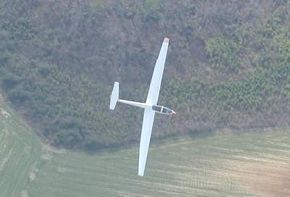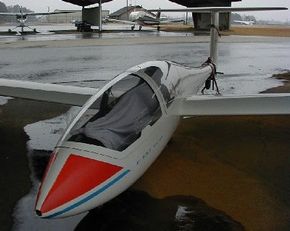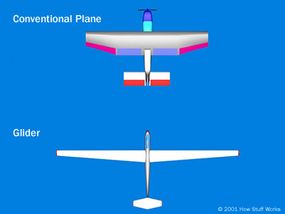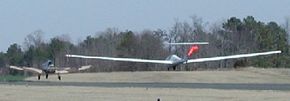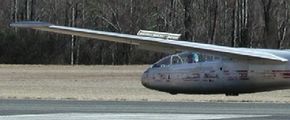The wings on a glider have to produce enough lift to balance the weight of the glider. The faster the glider goes the more lift the wings make. If the glider flies fast enough the wings will produce enough lift to keep it in the air. But, the wings and the body of the glider also produce drag, and they produce more drag the faster the glider flies. Since there's no engine on a glider to produce thrust, the glider has to generate speed in some other way. Angling the glider downward, trading altitude for speed, allows the glider to fly fast enough to generate the lift needed to support its weight.
The way you measure the performance of a glider is by its glide ratio. This ratio tells you how much horizontal distance a glider can travel compared to the altitude it has to drop. Modern gliders can have glide ratios better than 60:1. This means they can glide for 60 miles if they start at an altitude of one mile. For comparison, a commercial jetliner might have glide ratios somewhere around 17:1.
If the glide ratio were the only factor involved, gliders would not be able to stay in the air nearly as long as they do. So how do they do it?
The key to staying in the air for longer periods of time is to get some help from Mother Nature whenever possible. While a glider will slowly descend with respect to the air around it, what if the air around it was moving upward faster than the glider was descending? It's kind of like trying to paddle a kayak upstream; even though you may be cutting through the water at a respectable pace, you're not really making any progress with respect to the riverbank. The same thing works with gliders. If you are descending at one meter per second, but the air around the plane is rising at two meters per second, you're actually gaining altitude.
There are three main types of rising air used by glider pilots to increase flight times:
- Thermals
- Ridge lift
- Wave lift
Thermals
Thermals are columns of rising air created by the heating of the Earth's surface. As the air near the ground is heated by the sun, it expands and rises. Pilots keep an eye out for terrain that absorbs the morning sun more rapidly than surrounding areas. These areas, such as asphalt parking lots, dark plowed fields and rocky terrain, are a great way to find thermal columns. Pilots also keep a look out for newly forming cumulus clouds, or even large birds soaring without flapping their wings, which can also be signs of thermal activity.
Once a thermal is located, pilots will turn back and circle within the column until they reach their desired altitude at which time they will exit and resume their flight. To prevent confusion, gliders all circle in the same direction within thermals. The first glider in the thermal gets to decide the direction -- all the other gliders that join the thermal must circle in that direction.
Ridge Lift
Ridge lift is created by winds blowing against mountains, hills or other ridges. As the air reaches the mountain, it is redirected upward and forms a band of lift along the windward side of the slope. Ridge lift typically reaches no higher than a few hundred feet higher than the terrain that creates it. What ridge lift lacks in height however, it makes up for in length; gliders have been known to fly for a thousand miles along mountain chains using mostly ridge lift and wave lift.
Wave Lift
Wave lift is similar to ridge lift in that it is created when wind meets a mountain. Wave lift, however, is created on the leeward side of the peak by winds passing over the mountain instead of up one side. Wave lift can be identified by the unique cloud formations produced. Wave lift can reach thousands of feet high and gliders can reach altitudes of more than 35,000 feet.
Detecting Lift
Columns and bands of rising air obviously benefit any glider pilot, but how can you tell if you are flying in one? The answer is the variometer, a device that measures the rate of climb or descent. The variometer uses static pressure to detect changes in altitude. If the glider is rising, then the static pressure drops (because air pressure decreases the higher you go). If the glider is sinking, then the static pressure rises. The needle on the variometer indicates the rate of change in altitude based on the rate of change of static pressure. When flying through a rising mass of air (like a thermal), the needle on the variometer will jump (and usually beep to notify the pilot) before any change on the altimeter is even noticeable.
Detecting Yaw
The glider is yawing when it is not pointing exactly in the direction it is flying (relative to the air around it). Instead the glider is angled sideways and is "slipping" or "skidding" through the air. The string on the windshield indicates whether the glider is flying straight (string straight) or whether it is yawing (string left or right). The glider produces the least drag when it flies straight through the air. When it is yawing, the drag increases -- so in general, glider pilots try to keep the string straight.
